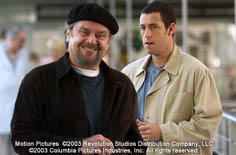
 |
|
| ||||||
|
ENTERTAINMENT Anger Acceptably Managed By Dan C., Grade 12, Fredericton High, Fredericton, NB
If ever there was a more eclectic duo of actors than Jack Nicholson and Adam Sandler, I've yet to see it. Despite this, or perhaps thanks to it, the two did not clash on screen as much as one might expect. Sandler plays Dave Buzznik, an executive assistant to the president of a large pet clothing company (yes, really), and the typical Hollywood formula (just add water, or an equally transparent performance by an equally transparent actor) doormat – often trodden on, submissive, reserved and always the Yes man. On a business flight, Buzznik encounters Dr. Buddy Rydell (played by Jack Nicholson), a not-so-conventional anger management therapist with eyebrows of steel and a resemblance to the devil incarnate. Buzznik then has a less than angry, but nonetheless unfortunate run in with a flight attendant and a disgruntled air marshal. From there, his luck does not improve and he has several subsequent run-ins with a variety of people – from waitresses to blind men. For these, he is sentenced to a month of anger management counseling from – you guessed it – Dr. Buddy Rydell. This is when we first see Rydell's unorthodox practices come into play – from his destruction of the Carpenter's albums (they were too "angry") to his insistence that he and Dave sleep in the same bed (with Rydell preferring to sleep in the nude – much to Buzznik's dismay) and that Dave prepare breakfast every morning for him (a breakfast of toast and eggs which, along with the plate on which it sat, would be thrown against the kitchen wall by the Doctor in favor of alpha bits – with which Rydell would spell out the word "chill" before telling Dave to calm down). The film would continue on in much the same manner for some time, with Rydell stealing Buzznik's long time girlfriend and would be fiancée, and consoling Buzznik by taking him to a she-male hooker. Buzznik was naturally and hilariously appalled. These are only a few of the encounters that take place in the film before it arrives at its funny, yet predictable conclusion. To the credit of the film, it wasn't entirely unbelievable. Many of the scenes were reminiscent of those days where nothing seems to go your way. On top of this, certain parts of the film depicted reality – former New York Mayor Rudy Giuliani at a Yankees game, for instance. Somewhat surprisingly, Sandler did well to make the story as believable as it could be when considering that it is a comedy, and that chances are no one's worst day will parallel Sandler's character's month with Dr. Buddy Rydell. This brings up Jack Nicholson. Throughout the course of the film, he perfectly captures the essence of the unorthodox and seemingly lunatic Rydell – leading the viewer to believe that if he were not a big time Hollywood actor, he would probably be a crazed, bordering on insane anger management therapist with a tendency to break out into his own rendition of "I Feel Pretty" from West Side Story. Because of Nicholson's superb deliverance of his lines and witticisms, the story is made far more believable. Director Peter Segal, while not completely devoid of story telling ability, did not do an overly commendable job of capturing and delivering the story to the viewer. Having said that, this is not the sort of film that demands it, as it is fairly straightforward, nor is it the sort of film that would lead to critics lauding a director for his ability. Due to these facts, Segal cannot be too harshly criticized. The cinematography in Anger Management was not overly spectacular. There were occasional parts where one might say to themselves "well, that was interesting", and there was the somewhat creative if not so original use of the typical "fireworks at Yankee Stadium as two lovers vow to marry" shot. So, while the cinematography was far from spectacular, it wasn't so bad as to be noticeable. The film does not present too much in the way of symbolism or irony (apart perhaps from the fact that Buzznik's childhood bully had now become a monk, only to revert back to his former, bullying self when confronted by the aforementioned Buzznik with the help of Rydell), and apart from the creative use of a tazer (which I can only hope was in fact done with the use of special effects), there was not much in the way of special effects either. If forced to rate this movie, I would give it a 7 out of 10. It isn't without its funny moments, and despite some shortcomings it isn't going to make you run back to the box office to demand a refund. As long as you don't go into it expecting a Tom Hanks in Forrest Gump or Denzel Washington in The Hurricane type performance, you won't be too let down.
|
||||||
 Anger Management
Anger Management